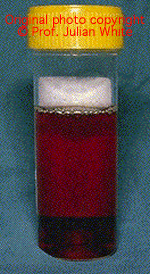
These are often related to the neurotoxins structurally (ie phospholipase A2 ) and they bind to the muscle fibres, causing progressive destruction of the muscle cells with release of breakdown products. It is likely this process takes hours to become evident, by which time irreversible damage has been done.
The result is progressive muscle weakness and pain on movement, with myoglobinuria and possible secondary renal failure and hyperkalaemia (which can be severe, intractable and lethal).
 |
Red discolouration of urine due to myolysis, resulting in myoglobinuria. |
Key early signs include; pain on contracting muscles against resistance, muscle weakness (may mimic paralytic signs, as above) and dark urine which tests positive for blood on dipstix.
Key laboratory tests; plasma CK, urinary myoglobin (qualitative only; positive "ward test" for blood), plasma potassium levels and renal function.
Key species; tiger snakes, mulga snake, taipans, rough scaled snake, sea snakes.
Value of antivenom treatment: limited clinical experience suggests that antivenom, even given several days after the bite, may sometimes cause a rapid resolution of symptoms (muscle pain) and a fall in CK.